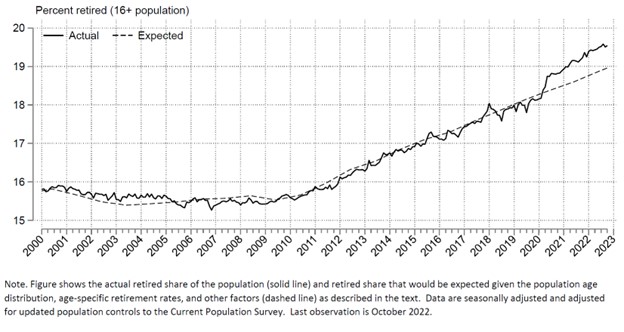George W. Hammond, EBRC director and Eller research professor
Labor force participation rates remain below pre-pandemic levels
Arizona dropped 600 seasonally-adjusted jobs over the month in March, down from a revised increase of 3,500 in February. The preliminary estimate put February growth at 5,700.
The losses in March were driven by education and health services (down 2,200), financial activities (down 1,600), professional and business services (down 1,000), other services (down 200), and natural resources and mining (down 100). Information jobs were stable over the month. Those losses were partly offset by gains in manufacturing (up 1,900), government (up 1,300), construction (up 700), leisure and hospitality (up 400), and trade, transportation, and utilities (up 200).
Arizona’s seasonally-adjusted unemployment rate ticked down to 3.5% in March from 3.7% in February. It was down slightly from March 2022 and equal to the national rate.
As Exhibit 1 shows, nearly all sectors in Arizona were well above their pre-pandemic high in March. The one exception remained government, especially local government.
In contrast, trade, transportation, and utilities jobs were up 50,700, with about one-half of the gain in transportation, warehousing, and utilities. Professional and business services job growth was driven primarily by professional and technological services. Note that manufacturing jobs were up 16,700 from February 2020.
Exhibit 1: Arizona Jobs by Industry, Change from February 2020 to March 2023, Seasonally Adjusted, Thousands
Arizona’s job growth has been accompanied by labor force gains, according to data from the Local Area Unemployment Statistics (LAUS) program. However, as Exhibit 2 shows, the labor force participation rate (for noninstitutionalized residents age 16 and older) remained below pre-pandemic levels for both the nation and the state.
Exhibit 2: Arizona and U.S. Labor Force Participation Rates, Seasonally Adjusted, Percent
According to a working paper from the Federal Reserve Board by Montes, Smith, and Dajon (2022-081), increased retirements account for much of the gap between current labor force participation rates and the pre-pandemic rate, at least through October 2022. Exhibit 3 shows actual retirements and retirements that we could have expected given demographic trends alone.
Exhibit 3: Percent of the U.S. Population Retired, Age 16 And Older, Percent
Their research suggests that more than one-half of the increase in the retired share was due to “excess retirements” due to the pandemic. Further, excess retirements were concentrated in the population age 65 and older, the college educated, and white workers. The results further suggest that excess retirements are likely to fade primarily because demographically driven retirements will continue to rise, not because individuals will choose to return to the labor market.






